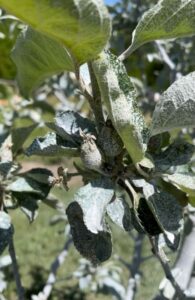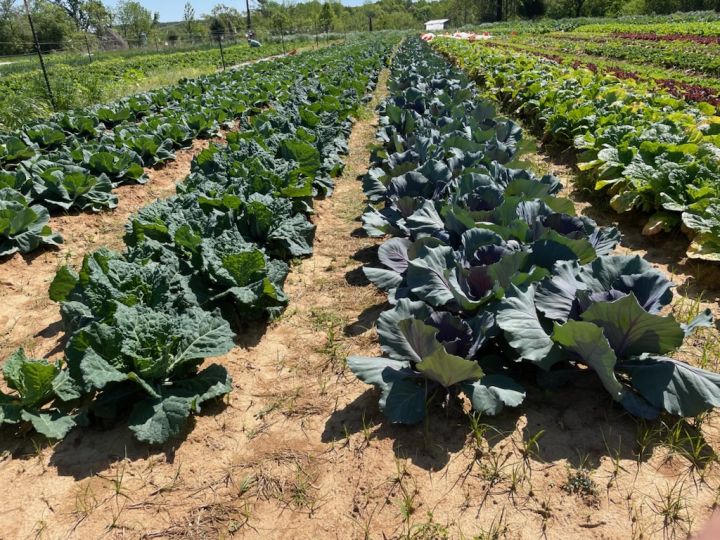
April was cool and some of our crops are a bit behind schedule (I’m looking at you, Napa cabbage!). But CSA is about celebrating what the garden gives us, even when it is erratic and different than we had planned. This week the shares are getting a lot of salad greens. And everyone is getting kohlrabi again. The beets and turnips and cabbage will catch up when they are good and ready.
Summer crops are on their way
I transplanted out the first succession of squash and zucchini on Monday. They grow quickly, and sometimes we have our first harvest before the end of May. I also planted out eggplant and basil, and direct seeded okra. While I was planting I saw that our living mulch of teff grass and buckwheat is coming up. I’ll be telling you more about our living mulch later in the season.
Predatory nematodes, a biological pest control strategy
Monday afternoon Randy hilled the potatoes. We ended up pulling all the volunteer sunflowers out by hand, as the wet weather had set hilling back about a week and both the potatoes and the sunflowers were getting pretty big. Pulling the sunflowers gave me and Guin a chance to find adult Colorado Potato Beetles, which have definitely found the potatoes! We’ve probably squashed close to 200 of them.
Our population of Colorado Potato Beetles (CPBs) has been growing. They used to be just a nuisance but in the past several years they have become a more significant problem. While we rotate where we plant the potatoes, our farm isn’t big enough to hide them from the pests, and we also have wild host plants.
Enter the nematodes! This is a new pest control strategy for us. Nematodes are microscopic animals that live in the soil and attack insects that have part of their life cycle in the soil. CPB’s pupate in the soil. I am hoping the use of nematodes will help get our CPB population in check. The nematodes come in a powder that we mix with water and apply to the soil with a backpack sprayer. My initial interest in the nematodes was to treat two other pests, root fly maggots that attack the turnips, the cucumber beetles which are a problem in cucumbers and melons. I got enough to spray an acre! Nematodes alone will not solve our pest problems, but hopefully we will notice a decrease in pest pressure.

Happy Apples
Another pest control measure happening right now is the spraying of the apple orchard with kaolin clay. A naturally occurring clay mineral, kaolin clay comes to us as a fine white powder. It is mixed with water and sprayed on the apple trees to form a film. It is not an insecticide because it doesn’t kill pests, but rather a physical barrier and pest irritant. When pests like the coddling moth visit the trees, they get the clay on their bodies and spend excessive time grooming. It makes it harder for them to feed and lay eggs. Now that blooming is finished and pollinators are no longer visiting the trees, we can begin applying the kaolin clay weekly to build up a good coating on the leaves and fruit.
Small Shares
- Strawberries
- Chard
- Lettuce Mix
- Arugula
- Kohlrabi
Full Shares
- Strawberries
- Chard
- Lettuce Mix
- Lettuce Mix with Arugula
- Kohlrabi
- Collards (Saturday will get komatsuna instead)




You must be logged in to post a comment.